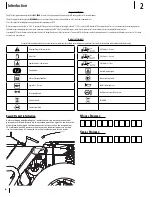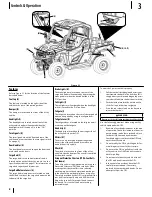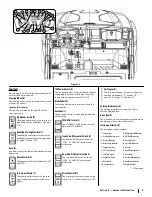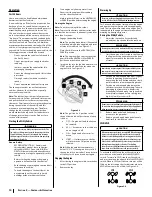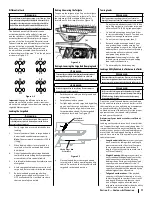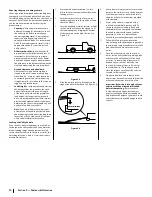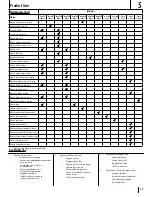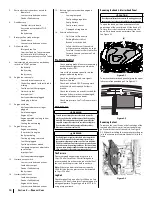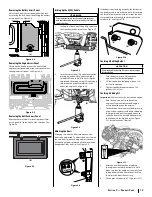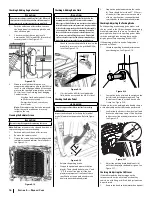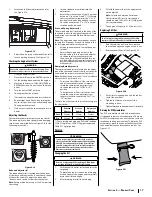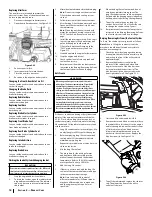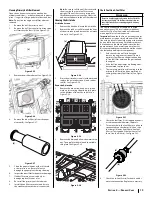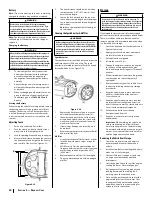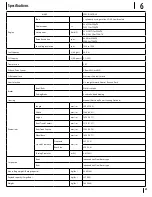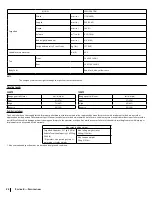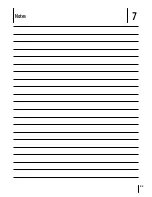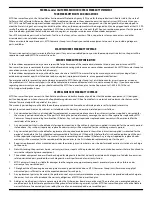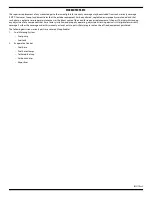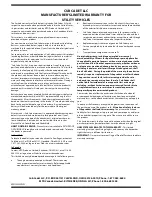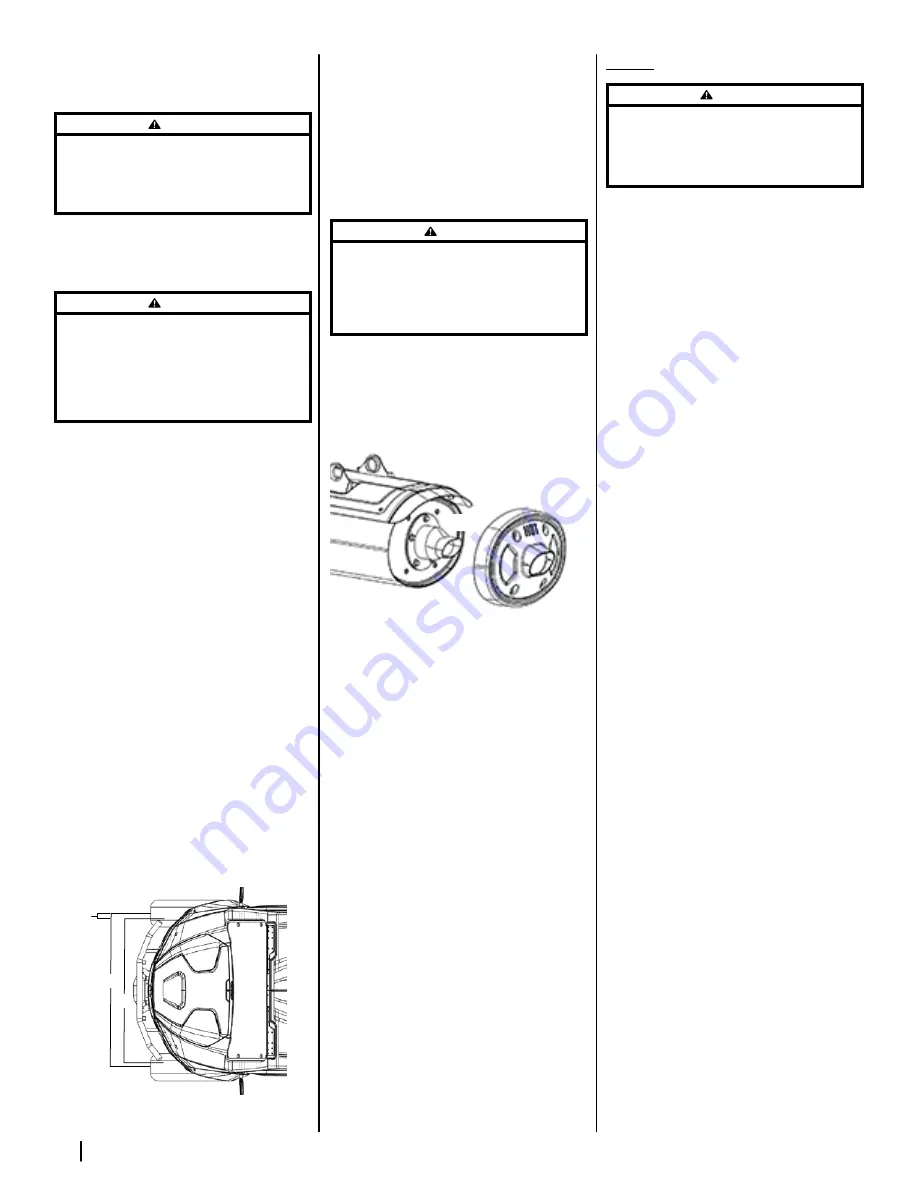
20
S
ection
5 — P
roduct
c
are
Battery
Note:
If you store a battery that is not completely
charged, the battery may need to be replaced.
WARNING
Never remove the battery while the engine is running.
Keep electrolyte away from eyes, hands and clothes. If you
are spattered with it, wash it away completely with water
immediately and get medical attention. Wear eye protection
and rubber gloves when working around the battery.
Note:
The factory installed battery is the non-
refillable type. If the battery is weak, charge or
replace it.
Charging the Battery
WARNING
When the battery is being active, hydrogen and oxygen gases
in the battery are extremely explosive. Keep open sparks and
flames away from the battery at all times, especially when
charging the battery. When disconnecting the cable from the
battery start with the negative terminal; when connecting the
cable to the battery start with the positive terminal. Always
check battery charge by using a voltmeter.
1.
To slow charge the battery connect the
battery positive terminal to the charger
positive terminal and the negative to
the negative. Then recharge the battery
normally.
2.
A boost charge is only for emergencies it
will partially charge the battery as quickly
as possible.
3.
When exchanging an old battery for a new
one, use a battery of equal specification.
The battery type is a
12V32Ah
,
12 volt
battery.
Storing the Battery
When storing the vehicle for a long period, remove
the battery and store in a dry place out of direct
sunlight. The battery will self-discharge while it
is stored. Recharge it once every three months
in hot seasons and once every six months in cold
seasons.
Adjusting Toe-In
1.
Park utility vehicle on flat surface.
2.
Turn the steering wheel so that the front
wheels are in the straight position.
3.
Lock the parking brake and stop the engine.
4.
Measure the distance between the center of
the front tires at hub height on the front (a)
and rear (b) of the tires. See Figure 5-33.
(a)
(c)
(b)
Figure 5-33
5.
The front distance should be shorter than
rear distance by 0-.47” (0-12 mm) (c) if not
adjust tie rod length.
6.
Loosen the lock nut and turn the inner tie
rod to adjust the rod length until the proper
toe-in measurement is obtained. Retighten
the lock nut.
Note:
Keep the length of the left and right
tie-rods equal.
Cleaning the Spark Arrester & Muffler
WARNING
Before touching any part of the exhaust system, be sure that
it has had sufficient time to cool. Always wear safety goggles
and face mask. The particulate matter contained in the muffler
contains chemicals that are harmful to people, animals and
marine life. If you are unable to do this work, have it done by
your dealer.
Spark Arrestor
The spark arrester (a) should be removed, inspected
and cleaned every 100 hours of use. The spark
arrester (a) is located inside of muffler (b) body and
fastened with bolts. See Figure 5-34.
(a)
(b)
(c)
Figure 5-34
1.
Remove the back cover (c) and loosen the
bolts and remove the spark arrester (a).
2.
Shake loosened particles out of the screen
assembly and lightly clean the screen with
wire brush. Soak in solvent and clean with
wire brush if necessary.
3.
If there is any damage, the assembly must
be replaced.
4.
Return the spark arrester (a) to the muffler (b)
and reinstall the bolts.
Muffler
1.
Visually check the muffler for cracks or holes
in the body, weldment or pipes at regular
intervals.
2.
USDA Forestry Division approval requires
clearance between spark arrester sleeve and
muffler body to be no larger than 0.023”
(0.584 mm).
3.
Replace the entire muffler if it is damaged.
4.
Do not operate the vehicle with a damaged
muffler.
Storage
WARNING
Do not clean the vehicle when the engine is running. To
avoid the danger of exhaust fume poisoning, do not operate
the engine in a closed building without proper ventilation.
When storing, remove the key from the key switch to avoid
unauthorized persons from operating the vehicle and
getting injured.
If you intend to store your vehicle for an extended
period of time, follow the procedures outlined below.
These procedures will insure that the vehicle is
ready to operate with minimum preparation when
it is removed from storage.
1.
Check the bolts and nuts for looseness and
tighten if necessary.
2.
Apply grease to vehicle areas where bare
metal will rust also to pivot areas.
3.
Unload from the cargo bed.
4.
Inflate the tire to 20 psi.
5.
Change the engine oil and run the engine
to circulate oil throughout the engine
block and internal moving parts for about 5
minutes.
6.
With all implements lowered to the ground,
coat any exposed rods with grease (if
equipped).
7.
Remove the battery from the vehicle. Store
the battery following the battery storage
procedures.
8.
Keep the vehicle in a dry place where the
vehicle is sheltered from the elements.
Cover the vehicle.
9.
Keep the vehicle indoors in a dry area that
is protected from sunlight and excessive
heat. If the vehicle must be stored outdoors.
Cover it with a waterproof tarpaulin.
10.
Put boards under the tires to keep
dampness away from tire.
11.
Keep the tries out of direct sunlight and
extreme heat.
Important:
When washing the vehicle, be
sure to stop the engine. Allow sufficient
time for the engine to cool before washing.
Do not wash with a high-pressure pressure
washer. Cover the vehicle after the muffler
and the engine have cooled down.
Removing the Vehicle from Storage
1.
Check the tire air pressure and adjust to
recommended pressures indicated on
vehicle.
2.
Install battery. Before installing the battery,
make sure it is fully charged.
3.
Check all fluid levels (engine oil, axle case
oil, engine coolant and any attached
implements).
4.
Start the engine. Check to see if the engine
cooling fan works. Observe all gauges.
5.
If all gauges are functioning properly and
reading normal and the cooling fan is
working, move the vehicle outside.
6.
Once outside, park the vehicle and let the
engine idle for at least five minutes. Shut
the engine off and work around vehicle
and make a visual inspection looking for
evidence of oil or water leaks.
Содержание 550 2017
Страница 23: ...Notes 7 23...
Страница 24: ...24 Section 7 Notes...
Страница 25: ...25 Section 7 Notes...

